
Eduard Karl Emanuel von Jachmann was the first Vizeadmiral of the Prussian Navy. He entered the navy in the 1840s after initially serving in the merchant marine. In 1848, Jachmann received his first command, the corvette SMS Amazone; through the 1850s and early 1860s, he held several other commands, including the frigates Thetis—aboard which he took part in the Eulenburg expedition to East Asia—and Arcona. During the Second Schleswig War in 1864, he commanded Prussian naval forces in the Baltic from Arcona, and led a small squadron at the Battle of Jasmund on 17 March. Though defeated in that battle, he was promoted to Konteradmiral for his aggressive handling of the Prussian fleet.
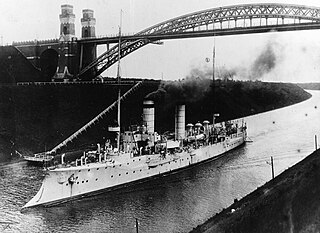
SMS Arcona was the ninth member of the ten-ship Gazelle class of light cruisers that were built for the German Kaiserliche Marine in the late 1890s and early 1900s. The Gazelle class was the culmination of earlier unprotected cruiser and aviso designs, combining the best aspects of both types in what became the progenitor of all future light cruisers of the Imperial fleet. Built to be able to serve with the main German fleet and as a colonial cruiser, she was armed with a battery of ten 10.5 cm (4.1 in) guns and a top speed of 21.5 knots. Arcona was a modified version of the basic Gazelle design, with improved armor and additional coal storage for a longer cruising range.

SMS Kaiser was the lead ship of the Kaiser-class ironclads; SMS Deutschland was her sister ship. Named for the title "Kaiser", held by the leader of the then newly created German Empire, the ship was laid down in the Samuda Brothers shipyard in London in 1871. The ship was launched in March 1874 and commissioned into the German fleet in February 1875. Kaiser mounted a main battery of eight 26 cm (10.2 in) guns in a central battery amidships.
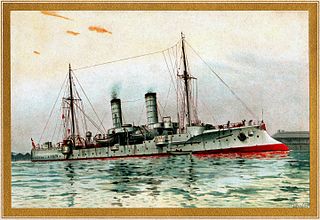
The Gazelle class was a group of ten light cruisers built for the Imperial German Navy at the turn of the 20th century. They were the first modern light cruiser design of the Imperial Navy, and set the basic pattern for all future light cruisers in Imperial service. The design of the Gazelle class attempted to merge the fleet scout with the colonial cruiser. They were armed with a main battery of ten 10.5 cm (4.1 in) guns and a pair of torpedo tubes, and were capable of a speed of 21.5 knots.

SMS Gefion was an unprotected cruiser of the German Kaiserliche Marine, the last ship of the type built in Germany. She was laid down in March 1892, launched in March 1893, and completed in June 1895 after lengthy trials and repairs. The cruiser was named after the earlier sail frigate Gefion, which had been named for the goddess Gefjon of Norse mythology. Intended for service in the German colonial empire and as a fleet scout, Gefion was armed with a main battery of ten 10.5-centimeter (4.1 in) guns, had a top speed in excess of 19.5 knots, and could steam for 3,500 nautical miles, the longest range of any German warship at the time. Nevertheless, the conflicting requirements necessary for a fleet scout and an overseas cruiser produced an unsuccessful design, and Gefion was rapidly replaced in both roles by the newer Gazelle class of light cruisers.

SMS Odin was the lead ship of her class of coastal defense ships built for the Imperial German Navy. She had one sister ship, Ägir. Odin, named for the eponymous Norse god, was built by the Kaiserliche Werft in Danzig between 1893 and 1896, and was armed with a main battery of three 24-centimeter (9.4 in) guns. She served in the German fleet throughout the 1890s and was rebuilt in 1901–1903. She served in the VI Battle Squadron after the outbreak of World War I in August 1914, but saw no action. Odin was demobilized in 1915 and used as a tender thereafter. After the war, she was rebuilt as a merchant ship and served in this capacity until 1935, when she was broken up for scrap.

SMS Comet was an aviso of the German Kaiserliche Marine built in the early 1890s, second and final member of the Meteor class that include one other vessel, Meteor. Intended to screen the main fleet against attacking torpedo boats, Comet was armed with a battery of four 8.8 cm (3.5 in) guns. Her design suffered from several defects, including excessive vibration and poor handling in heavy seas, both of which could not be corrected. These problems limited the ship's career to several periods of sea trials as the navy attempted to remedy the problems that plagued the ship. They had no success, and Comet was instead decommissioned in mid-1896 and was later converted into a storage hulk for naval mines. She was ultimately broken up in 1921.
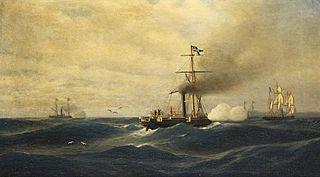
SMS Meteor was a Camäleon-class gunboat of the North German Federal Navy that was launched in 1865. A small vessel, armed with only three light guns, Meteor took part in the Battle of Havana in 1870 during the Franco-Prussian War. There, she battled the French aviso Bouvet; both vessels were lightly damaged, though Bouvet was compelled to disengage after a shot from Meteor disabled her engine. After the war, Meteor returned to Germany, where her career was limited; she served briefly as a survey vessel. From 1873 to 1877, she was deployed to the Mediterranean Sea as a station ship in Constantinople during a period of tensions in the Ottoman Empire. After returning to Germany in 1877, she was decommissioned, converted into a coal hulk and expended as a target ship some time later.
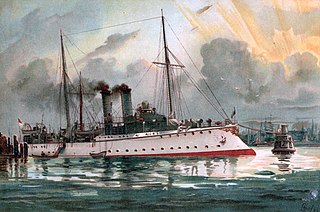
SMS Iltis was the lead ship of the Iltis class of gunboats built for the German Kaiserliche Marine in the late 1890s and early 1900s. Other ships of the class are SMS Luchs, SMS Tiger, SMS Eber, SMS Jaguar, and SMS Panther.

SMS Jaguar was the second member of the Iltis class of gunboats built for the German Kaiserliche Marine in the late 1890s and early 1900s, for overseas service in the German colonial empire. Other ships of the class are SMS Iltis, SMS Luchs, SMS Tiger, SMS Eber and SMS Panther.

SMS Luchs was the fourth member of the Iltis class of gunboats built for the German Kaiserliche Marine in the late 1890s and early 1900s. Other ships of the class are SMS Iltis, SMS Tiger, SMS Eber, SMS Jaguar and SMS Panther.

SMS Tiger was the third member of the Iltis class of gunboats built for the German Kaiserliche Marine in the late 1890s and early 1900s. Other ships of the class were SMS Iltis, SMS Luchs, SMS Eber, SMS Jaguar and SMS Panther.
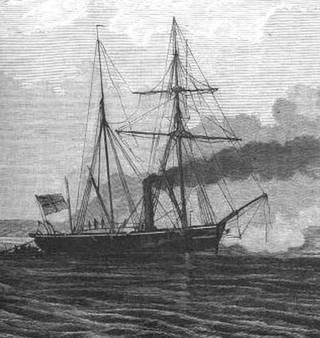
SMS Blitz was a Camäleon-class gunboat of the Prussian Navy that was launched in 1862. A small vessel, armed with only three light guns, Blitz served during all three wars of German unification in the 1860s and early 1870s. The ship was present during the Battle of Heligoland in May 1864 during the Second Schleswig War, but was too slow to engage the Danish squadron. During the Austro-Prussian War of 1866, she operated against the Kingdom of Hanover in the North Sea, but did not see extensive action. In August 1870, Blitz and three other light vessels attacked the French blockade force in the Baltic Sea during the Franco-Prussian War, but they withdrew without either side scoring any hits. During her peacetime career, Blitz was sent to the Mediterranean Sea twice, in 1863 and 1867–1868. She was employed as a fisheries protection ship, a guard ship, and a survey vessel in the early 1870s, before being decommissioned in 1875 and broken up for scrap in 1878. Parts of her machinery were reused in the gunboat Wolf.

SMS Basilisk was a Camäleon-class gunboat of the Prussian Navy that was launched in 1862. A small vessel, armed with only three light guns, Basilisk served during all three wars of German unification in the 1860s and early 1870s. The ship was present during the Battle of Heligoland in May 1864 during the Second Schleswig War, but was too slow to engage the Danish squadron. During the Austro-Prussian War of 1866 and the Franco-Prussian War of 1870–1871, Basilisk was stationed in the North Sea to help defend the coast, but she did not see action during either conflict. Between 1873 and 1875, she was employed experimentally as the first torpedo-armed warship of the German fleet. Basilisk was decommissioned in 1875, renamed "Mine Barge No. 1", and converted into a naval mine storage hulk. The details of her fate are unrecorded, but she was still in service in that capacity at least as late as 1900. Sometime thereafter, she was broken up.

SMS Cyclop was a Camäleon-class gunboat of the Prussian Navy that was launched in 1860. A small vessel, armed with only three light guns, Cyclop served during the three wars of German unification; during the first, the Second Schleswig War on 1864, she guarded the Prussian coastline but saw no action. She supported the army's campaign against the Kingdom of Hanover during the Austro-Prussian War of 1866, and she defended the Elbe for the duration of the Franco-Prussian War of 1870–1871, but again took part in no battles. Badly deteriorated by 1872, she was stricken from the naval register in March that year and reconstructed into an iron-hulled gunboat. Recommissioned in 1875, she thereafter served abroad in the German colonial empire before being stricken again in 1888. She was thereafter used as a storage hulk before ultimately being broken up for scrap after 1914.

SMS Drache was a Camäleon-class gunboat of the Prussian Navy that was launched in 1860. Budgetary problems delayed her completion until 1869, and she first entered service during the Franco-Prussian War in 1870, though she saw no significant action against the French Navy. Drache spent most of her career, between 1872 and 1887, conducting survey work in the North Sea, which later proved to be instrumental to the operations of German U-boats and minelayers during World War I. Drache was ultimately decommissioned in 1887, reduced to a coal hulk, and then expended as a target for the torpedo boat D5 in 1889. Her wreck was later raised and broken up.

SMS Arcona was a member of the Carola class of steam corvettes built for the German Kaiserliche Marine in the 1880s. Intended for service in the German colonial empire, the ship was designed with a combination of steam and sail power for extended range, and was equipped with a battery of ten 15-centimeter (5.9 in) guns. Arcona was laid down at the Kaiserliche Werft in Danzig in 1881, she was launched in May 1885, and she was completed in December 1886.

SMS Nymphe was the lead ship of the Nymphe class of steam corvettes, the first ship of that type to be built for the Prussian Navy. She had one sister ship, Medusa, and the vessels were wooden-hulled ships armed with a battery of sixteen guns. She was ordered as part of a naval expansion program to counter the Danish Navy over the disputed ownership of Schleswig and Holstein. Nymphe was laid down in January 1862, was launched in April 1863, and was completed in October that year.















